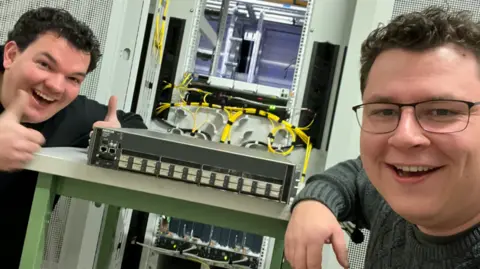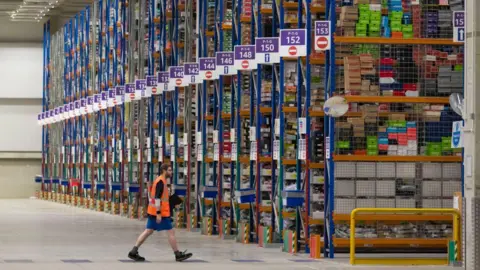Sci-Tech
The fastest data in the world

By Chris Baraniuk, Technology Reporter
 surf
surfAs IT updates go, this was about as nerve-wracking as things can get.
In February, deep inside a warehouse at Cern, the Swiss home of the Large Hadron Collider (LHC) – the world’s biggest science experiment – two network engineers held their breath. And pressed a button.
Suddenly, text on a black background flashed up on a screen in front of them. It had worked. “There was high-fiving involved,” recalls Joachim Opdenakker at SURF, a Dutch IT association that works for educational and research institutions. “It was super-cool to see.”
He and his colleague Edwin Verheul had just set up a new data link between the LHC in Switzerland and data storage sites in The Netherlands.
A data link that could reach speeds of 800 gigabits per second (Gbps) – or more than 11,000 times the average UK home broadband speed. The idea is to improve scientists’ access to the results of LHC experiments.
A subsequent test in March using special equipment on loan from Nokia proved the desired speeds were achievable.
“This transponder that Nokia uses, it’s like a celebrity,” says Mr Verheul, explaining how the kit is booked up for use at various locations in advance. “We had limited time to do tests. If you have to postpone a week, then the transponder is gone.”
This amount of bandwidth, approaching one terabit per second, is extremely fast but some subsea cables are a few hundred times faster still – they use multiple fibre strands to achieve such speeds.
 Nokia & Surf
Nokia & SurfIn labs around the world, networking experts are coming up with fibre optic systems capable of pushing data around even more rapidly than this. They are reaching extraordinary speeds of many petabits per second (Pbps), or 300 million times the average UK home broadband connection.
This is so fast that one can barely imagine how people will use such bandwidth in the future. But engineers are wasting no time in proving that it is possible. And they only want to go faster.
The duplex cable (with cores that either send or receive) from Cern to data centres in The Netherlands is just shy of 1,650km (I,025 miles) long, snaking from Geneva to Paris, then Brussels, and finally Amsterdam. Part of the challenge in reaching 800 Gbps was in beaming pulses of light such a long way. “Due to the distance, the power levels of that light decrease, so you have to amplify it at different locations,” explains Mr Opdenakker.
Every time one tiny subatomic particle smashes into another during experiments at the LHC, the impact generates staggering volumes of data – about one petabyte per second. That’s enough to fill 220,000 DVDs.
This is slimmed down for storage and study, but still requires hefty amounts of bandwidth. Plus, with an upgrade due by 2029, the LHC expects to produce even more scientific data than it does today.
“The upgrade increases the number of collisions by at least a factor of five,” says James Watt, senior vice president and general manager of optical networks at Nokia.
A time when 800 Gbps seems slow may not be far away, however. In November, a team of researchers in Japan broke the world speed record for data transmission when they reached an astonishing 22.9 Pbps. That’s enough bandwidth to supply every single person on the planet, and then a couple billion more, with a Netflix stream, says Chigo Okonkwo at Eindhoven University of Technology, who was involved in the work.
In this case, a meaningless but huge stream of pseudorandom data was beamed over 13km of coiled fibre optic cable in a lab setting. Dr Okonkwo explains that the integrity of the data is analysed post-transfer to confirm it was sent as quickly as reported without accumulating too many errors.
He also adds that the system he and colleagues used relied on multiple cores – a total of 19 cores inside one fibre cable. This is a new type of cable unlike the standard ones that connect many people’s home to the internet.
But older fibre is expensive to dig up and replace. Extending its lifetime is useful, argues Wladek Forysiak at Aston University in the UK. He and colleagues have recently achieved speeds of around 402 terabits per second (Tbps) along a 50km-long optical fibre with just one core. That’s about 5.7 million times faster than the average UK home broadband connection.
“I think it’s a world best, we don’t know of any results that are better than that,” says Prof Forysiak. Their technique relies on using more wavelengths of light than usual when flashing data down an optical line.
For this they use alternative forms of the electronic equipment that sends and receives signals over fibre optic cables but such a setup could be easier to install than replacing thousands of kilometres of the cable itself.
Activities in the so-called metaverse might one day require extreme bandwidth, suggests Martin Creaner, director general of the World Broadband Association. His organisation expects home broadband connections to reach up to 50 Gbps by 2030.
But reliability may be even more important than speed for some applications. “For remote robotic surgery across 3,000 miles… you absolutely do not want any scenario where the network goes down,” says Mr Creaner.
Dr Okonkwo adds that training AI will increasingly require moving huge datasets around. The faster this can be done, the better, he argues.
And Ian Phillips, who works alongside Prof Forysiak, says bandwidth tends to find applications once it is available: “Humanity finds a way of consuming it.”
 TeleGeography
TeleGeographyAlthough multiple petabits per second is far beyond what today’s web users need, Lane Burdette, research analyst at TeleGeography, a telecoms market research firm, says it is striking how quickly demand for bandwidth is growing – currently, at around 30% year-on-year on transatlantic fibre optic cables.
Content provision – social media, cloud services, video streaming – is eating up far more bandwidth than before, she notes: “It used to be like 15% of international bandwidth in the early 2010’s. Now it’s up to three quarters, 75%. It’s absolutely massive.”
In the UK, there is still a long way to go to improve internet speeds. Many people cannot access sufficiently fast broadband at home.
Andrew Kernahan, head of public affairs at the Internet Service Providers Association says most home users can now access gigabit per second speeds.
However, only about a third of broadband customers are signing up for such technology. There’s no “killer app” at the moment that really requires it, says Mr Kernahan. This might change as more and more TV is consumed via the internet, for example.
“There’s definitely a challenge to get the message out there and make people more aware of what they can do with the infrastructure,” he says.
Sci-Tech
what next for ‘The Everything Company’?

By Tom Singleton, Technology reporter
 Getty Images
Getty ImagesThree decades on from the day it began, it is hard to get your head around the scale of Amazon.
Consider its vast warehouse in Dartford, on the outskirts of London. It has millions of stock items, with hundreds of thousands of them bought every day – and it takes two hours from the moment something is ordered, the company says, for it to be picked, packed and sent on its way.
Now, picture that scene and multiply it by 175. That’s the number of “fulfilment centres”, as Amazon likes to call them, that it has around the world.
Even if you think you can visualise that never-ending blur of parcels crisscrossing the globe, you need to remember something else: that’s just a fraction of what Amazon does.
It is also a major streamer and media company (Amazon Prime Video); a market leader in home camera systems (Ring) and smart speakers (Alexa) and tablets and e-readers (Kindle); it hosts and supports vast swathes of the internet (Amazon Web Services); and much more besides.
“For a long time it has been called ‘The Everything Store’, but I think, at this point, Amazon is sort of ‘The Everything Company’,” Bloomberg’s Amanda Mull tells me.
“It’s so large and so omnipresent and touches so many different parts of life, that after a while, people sort of take Amazon’s existence in all kinds of elements of daily life sort of as a given,” she says.
Or, as the company itself once joked, pretty much the only way you could get though a day without enriching Amazon in some way was by “living in a cave”.
 Getty Images
Getty ImagesSo the story of Amazon, since it was founded by Jeff Bezos in 1994, has been one of explosive growth, and continual reinvention.
There has been plenty of criticism along the way too, over “severe” working conditions and how much tax it pays.
But the main question as it enters its fourth decade appears to be: once you are The Everything Company, what do you do next?
Or as Sucharita Kodali, who analyses Amazon for research firm Forrester, puts it: “What the heck is left?”
“Once you’re at a half a trillion dollars in revenue, which they already are, how do you continue to grow at double digits year over year?”
One option is to try to tie the threads between existing businesses: the vast amounts of shopping data Amazon has for its Prime members might help it sell adverts on its streaming service, which – like its rivals – is increasingly turning to commercials for revenue.
But that only goes so far – what benefits can Kuiper, its satellite division, bring to Whole Foods, its supermarket chain?
To some extent, says Sucharita Kodali, the answer is to “keep taking swings” at new business ventures, and not worry if they fall flat.
Just this week Amazon killed a business robot line after only nine months – Ms Kodali says that it is just one of a “whole graveyard of bad ideas” the company tried and discarded in order to find the successful ones.
But, she says, Amazon may also have to focus on something else: the increasing attention of regulators, asking difficult questions like what does it do with our data, what environmental impact is it having, and is it simply too big?
All of these issues could prompt intervention “in the same way that we rolled back the monopolies that became behemoths in the early 20th century”, Ms Kodali says.
For Juozas Kaziukėnas, founder of e-commerce intelligence firm Marketplace Pulse, its size poses another problem: the places its Western customers live in simply can not take much more stuff.
“Our cities were not built for many more deliveries,” he tells the BBC.
That makes emerging economies like India, Mexico and Brazil important. But, Mr Kaziukėnas, suggests, there Amazon does not just need to enter the market but to some extent to make it.
“It’s crazy and maybe should not be the case – but that’s a conversation for another day,” he says.
 Getty Images
Getty ImagesAmanda Mull points to another priority for Amazon in the years ahead: staving off competition from Chinese rivals like Temu and Shein.
Amazon, she says, has “created the spending habits” of western consumers by acting as a trusted intermediary between them and Chinese manufacturers, and bolting on to that easy returns and lightening fast delivery.
But remove that last element of the deal and you can bring prices down, as the Chinese retailers have done.
“They have said ‘well, if you wait a week or 10 days for something that you’re just buying on a lark, we can give it to you for almost nothing,'” says Ms Mull – a proposition that is appealing to many people, especially during a cost of living crisis.
Juozas Kaziukėnas is not so sure – suggesting the new retailers will remain “niche”, and it will take something much more fundamental to challenge Amazon’s position.
“For as long as going shopping involves going to a search bar – Amazon has nailed that,” he says.
Thirty years ago a fledging company spotted emerging trends around internet use and realised how it could upend first retail, then much else besides.
Mr Kaziukėnas says for that to happen again will take a similar leap of imagination, perhaps around AI.
“The only threat to Amazon is something that doesn’t look like Amazon,” he says.
Sci-Tech
Ray Kurzweil Still Says He Will Merge With A.I.

Sitting near a window inside Boston’s Four Seasons Hotel, overlooking a duck pond in the city’s Public Garden, Ray Kurzweil held up a sheet of paper showing the steady growth in the amount of raw computer power that a dollar could buy over the last 85 years.
A neon-green line rose steadily across the page, climbing like fireworks in the night sky.
That diagonal line, he said, showed why humanity was just 20 years away from the Singularity, a long hypothesized moment when people will merge with artificial intelligence and augment themselves with millions of times more computational power than their biological brains now provide.
“If you create something that is thousands of times — or millions of times — more powerful than the brain, we can’t anticipate what it is going to do,” he said, wearing multicolored suspenders and a Mickey Mouse watch he bought at Disney World in the early 1980s.
Mr. Kurzweil, a renowned inventor and futurist who built a career on predictions that defy conventional wisdom, made the same claim in his 2005 book, “The Singularity Is Near.” After the arrival of A.I. technologies like ChatGPT and recent efforts to implant computer chips inside people’s heads, he believes the time is right to restate his claim. Last week, he published a sequel: “The Singularity Is Nearer.”
Now that Mr. Kurzweil is 76 years old and is moving a lot slower than he used to, his predictions carry an added edge. He has long said he plans to experience the Singularity, merge with A.I. and, in this way, live indefinitely. But if the Singularity arrives in 2045, as he claims it will, there is no guarantee he will be alive to see it.
“Even a healthy 20-year-old could die tomorrow,” he said.
But his prediction is not quite as outlandish as it seemed in 2005. The success of the chatbot ChatGPT and similar technologies has encouraged many prominent computer scientists, Silicon Valley executives and venture capitalists to make extravagant predictions about the future of A.I. and how it will alter the course of humanity.
Tech giants and other deep-pocketed investors are pumping billions into A.I. development, and the technologies are growing more powerful every few months.
Many skeptics warn that extravagant predictions about artificial intelligence may crumble as the industry struggles with the limits of the raw materials needed to build A.I., including electrical power, digital data, mathematics and computing capacity. Techno-optimism can also feel myopic — and entitled — in the face of the world’s many problems.
“When people say that A.I. will solve every problem, they are not actually looking at what the causes of those problems are,” said Shazeda Ahmed, a researcher at the University of California, Los Angeles, who explores claims about the future of A.I.
The big leap, of course, is imagining how human consciousness would merge with a machine, and people like Mr. Kurzweil struggle to explain how exactly this would happen.
Born in New York City, Mr. Kurzweil began programming computers as a teenager, when computers were room-size machines. In 1965, as a 17-year-old, he appeared on the CBS television show “I’ve Got a Secret,” performing a piano piece composed by a computer that he designed.
While still a student at Martin Van Buren High School in Queens, he exchanged letters with Marvin Minsky, one of the computer scientists who founded the field of artificial intelligence at a conference in the mid-1950s. He soon enrolled at the Massachusetts Institute of Technology to study under Dr. Minsky, who had become the face of this new academic pursuit — a mix of computer science, neuroscience, psychology and an almost religious belief that thinking machines were possible.
When the term artificial intelligence was first presented to the public during a 1956 conference at Dartmouth College, Dr. Minsky and the other computer scientists gathered there did not think it would take long to build machines that could match the power of the human brain. Some argued that a computer would beat the world chess champion and discover its own mathematical theorem within a decade.
They were a bit too optimistic. A computer would not beat the world chess champion until the late 1990s. And the world is still waiting for a machine to discover its own mathematical theorem.
After Mr. Kurzweil built a series of companies that developed everything from speech recognition technologies to music synthesizers, President Bill Clinton awarded him the National Medal of Technology and Innovation, the country’s highest honor for achievement in tech innovation. His profile continued to rise as he wrote a series of books that predicted the future.
Around the turn of the century, Mr. Kurzweil predicted that A.I. would match human intelligence before the end of the 2020s and that the Singularity would follow 15 years later. He repeated these predictions when the world’s leading A.I. researchers gathered in Boston in 2006 to celebrate the field’s 50th anniversary.
“There were polite snickers,” said Subbarao Kambhampati, an A.I. researcher and Arizona State University professor.
A.I. began to rapidly improve in the early 2010s as a group of researchers at the University of Toronto explored a technology called a neural network. This mathematical system could learn skills by analyzing vast amounts of data. By analyzing thousands of cat photos, it could learn to identify a cat.
It was an old idea dismissed by the likes of Dr. Minsky decades before. But it started to work in eye-opening ways, thanks to the enormous amounts of data the world had uploaded onto the internet — and the arrival of the raw computing power needed to analyze all that data.
The result, in 2022, was ChatGPT. It had been driven by that exponential growth in computing power.
Geoffrey Hinton, the University of Toronto professor who helped develop neural network technology and may be more responsible for its success than any other researcher, once dismissed Mr. Kurzweil’s prediction that machines would exceed human intelligence before the end of this decade. Now, he believes it was insightful.
“His prediction no longer looks so silly. Things are happening much faster than I expected,” said Dr. Hinton, who until recently worked at Google, where Mr. Kurzweil has led a research group since 2012.
Dr. Hinton is among the A.I. researchers who believe that the technologies driving chatbots like ChatGPT could become dangerous — perhaps even destroy humanity. But Mr. Kurzweil is more optimistic.
He has long predicted that advances in A.I. and nanotechnology, which could alter the microscopic mechanisms that control the way our bodies behave and the diseases that afflict them, will push back against the inevitability of death. Soon, he said, these technologies will extend lives at a faster rate than people age, eventually reaching an “escape velocity” that allows people to extend their lives indefinitely.
“By the early 2030s, we won’t die because of aging,” he said.
If he can reach this moment, Mr. Kurzweil explained, he can probably reach the Singularity.
But the trends that anchor Mr. Kurzweil’s predictions — simple line graphs showing the growth of computer power and other technologies over long periods of time — do not always keep going the way people expect them to, said Sayash Kapoor, a Princeton University researcher and co-author of the influential online newsletter “A.I. Snake Oil” and a book of the same name.
When a New York Times reporter asked Mr. Kurzweil if he was predicting immortality for himself back in 2013, he replied: “The problem is I can’t get on the phone with you in the future and say, ‘Well, I’ve done it, I have lived forever,’ because it’s never forever.” In other words, he could never be proved right.
But he could be proved wrong. Sitting near the window in Boston, Mr. Kurzweil acknowledged that death comes in many forms. And he knows that his margin of error is shrinking.
He recalled a conversation with his aunt, a psychotherapist, when she was 98 years old. He explained his theory of life longevity escape velocity — that people will eventually reach a point where they can live indefinitely. She replied: “Can you please hurry up with that?” Two weeks later, she died.
Though Dr. Hinton is impressed with Mr. Kurzweil’s prediction that machines will become smarter than humans by the end of the decade, he is less taken with the idea that the inventor and futurist will live forever.
“I think a world run by 200-year-old white men would be an appalling place,” Dr. Hinton said.
Audio produced by Patricia Sulbarán.
Sci-Tech
Robots Get a Fleshy Face (and a Smile) in New Research

Engineers in Japan are trying to get robots to imitate that particularly human expression — the smile.
They have created a face mask from human skin cells and attached it to robots with a novel technique that conceals the binding and is flexible enough to turn down into a grimace or up into a squishy smile.
The effect is something between Hannibal Lecter’s terrifying mask and the Claymation figure Gumby.
But scientists say the prototypes pave the way for more sophisticated robots, with an outward layer both elastic and durable enough to protect the machine while making it appear more human.
Beyond expressiveness, the “skin equivalent,” as the researchers call it, which is made from living skin cells in a lab, can scar and burn and also self-heal, according to a study published June 25 in the journal Cell Reports Physical Science.
“Human-like faces and expressions improve communication and empathy in human-robot interactions, making robots more effective in health care, service and companionship roles,” Shoji Takeuchi, a professor at the University of Tokyo and the study’s lead researcher, said in an email.
The research comes as robots are becoming more ubiquitous on factory floors.
There were 3.9 million industrial robots working on auto and electronics assembly lines and other work settings in 2022, according to the International Federation of Robotics.
A subset of the total robot stock includes so-called humanoids, machines designed with two arms and two legs that enable them to work in environments that were built for human workers, such as factories, but also in hospitality, health care and education.
Carsten Heer, a federation spokesman, said that humanoids were “an exciting area of development” but that mass market adoption would be complex, and could be constrained by cost.
Still, in October 2023, the Chinese government announced a goal of mass-producing humanoids by 2025, which it predicted would greatly increase its industrial productivity.
For decades, robotic engineers have experimented with materials, hoping to find something that could both protect a robot’s complex machinery but be soft and light enough for a wide range of uses.
If the surface of a robot gets dinged or scratched, it can lead to machine malfunction, making the capacity for self-repair a “critical feature” for humanoid robots, the researchers said in the paper.
The novel skin attachment method advances the nascent field of “biohybrid” robotics, which integrates mechanical engineering with genetic and tissue engineering, said Kevin Lynch, director of the Center for Robotics and Biosystems at Northwestern University.
“This study is an innovative contribution to the problem of anchoring artificial skin to the underlying material,” Professor Lynch said, adding that “living skin may help us achieve the holy grail of self-healing skins in biohybrid robots.”
He added that the study does not address how the robots’ skin will self-heal without external support.
For such robots, the materials’ challenge extends to verisimilitude — finding ways to imbue the machine with characteristics that make it appear and behave more like a human, such as the ability to smile.
Scientists, including Professor Takeuchi and his colleagues at the University of Tokyo, have been working with lab-made human skin for years.
In 2022, the research team developed a robotic finger covered in living skin, allowing the machine’s digit to bend like a human finger, giving it the tactility to potentially perform more precise tasks.
Professor Takeuchi’s team had tried anchoring the skin with mini-hooks, but those caused tears as the robot moved. So the team decided to mimic ligaments, the tiny ropes of loose tissue that connect bones.
Team members drilled small, V-shaped holes into the robot and applied a gel containing collagen, which plugged the holes and tethered the artificial skin to the robot.
“This approach integrates traditional rigid robots with soft, biological skins, making them more ‘humanlike,’” said Yifan Wang, an assistant professor at the school of mechanical and aerospace engineering at Nanyang Technological University in Singapore who researches “soft robots” that mimic biological creatures.
The skin binding also gives a biohybrid robot the potential for sensation, taking science one step closer to sci-fi fantasy.
“This could create opportunities for the robot to sense, and safely interact with humans,” Professor Wang said.
The faces of the robots with artificial skin in Professor Takeuchi’s lab do not have the capability to sense touch or temperature change or other external stimuli.
Professor Takeuchi said that is his next research target.
“We aim to create skin that closely mimics the functionality of real skin by gradually constructing essential components such as blood vessels, nerves, sweat glands, sebaceous glands and hair follicles,” he said.
In place of the neural systems that convey sensation in a human body, a robot’s electronics would need to power a sensor signal — a development that Professor Wang said would require much more time and research.
-

 African History5 years ago
African History5 years agoA Closer Look: Afro-Mexicans 🇲🇽
-

 African History5 months ago
African History5 months agoBlack History Facts I had to Learn on My Own pt.6 📜
-

 African History5 years ago
African History5 years agoA Closer Look: Afro-Mexicans 🇲🇽
-

 African History1 year ago
African History1 year agoMajor African Tribes taken away during the Atlantic Slave Trade🌍 #slavetrade #africanamericanhistory
-

 African History1 year ago
African History1 year agoCameroon 🇨🇲 World Cup History (1962-2022) #football #realmadrid #shorts
-

 African History5 months ago
African History5 months agoBlack History Inventors: Mary Kenner 🩸
-

 African History1 year ago
African History1 year agoPROOF AFRICAN AMERICANS AIN'T FROM AFRICA DOCUMENTED EVIDENCE
-

 African History1 year ago
African History1 year agoNo African pre-Columbus DNA? 🤯🤯 #history #mesoamerica #mexico #african


























